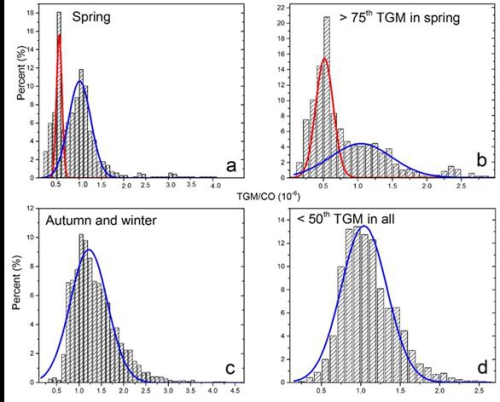 |
|
Figure 1 Frequencies of TGM/CO ratios observed at Mt. Ailao Observatory Station. (Image by IGCAS)
*TGM: total gaseous mercury
|
Biomass burning is an important source of atmospheric mercury (Hg). Mean global Hg emission from biomass burning rivals the global emission from anthropogenic sources and accounts for ~10% of total global Hg emissions. Hg emission from biomass burning contains up to 50% of particulate bounded mercury (PBM) and therefore has a high deposition potential. The emission characteristics, such as rapid release and emission speciation, enhance local deposition that causes a higher risk of accumulation and bioconcentration of MeHg (a neurotoxic pollutant).
Indo-China Peninsula is the region where biomass burning most frequently occurs during springtime in Asia. Judging Southwest China bordering the Indo-China Peninsula region, such biomass burning in the region should be regarded as an important source for the elevated atmospheric Hg in the Southwest China.
To assess the transboundary transport and impact of Hg emissions from biomass burning in the Indo-China Peninsula, Prof. FENG Xinbin’s research group at the Institute of Geochemistry, Chinese Academy of Sciences (IGCAS) has studied the 2-year observed data of Hg and CO concentrations at a high-altitude background site in southwestern China (Mt. Ailao Observatory Station).
The study revealed that transboundary transport of Hg from biomass burning in Indo-China Peninsula led to episodically elevated atmospheric Hg concentrations at Mt. Ailao. About 25% of the observed Hg/C ratios during springtime were caused by the transboundary transport of Hg from biomass burning in this region. Hg emission from biomass burning in Indo-China Peninsula was estimated to be 11.4±2.1Mg yr-1.
In addition, Hg emissions from biomass burning contained a substantial fraction of PBM. The local Hg deposition caused by the PBM was estimated to be 2.2±0.4 Mg yr-1. Compared to ~25 Mg yr-1 anthropogenic emissions in this region, such strong springtime emissions potentially pose a threat to the ecosystems of the Indo-China Peninsula and southwest China.
This study was funded by National "973" Program of China (2013CB430003) and the State Key Laboratory of Environmental Geochemistry, IGCAS. Specifically, the researchers appreciate the support from Ailaoshan Station for Subtropical Forest Ecosystem Studies.
The paper (Transboundary transport and deposition of Hg emission from springtime biomass burning in the Indo-China Peninsula,doi:10.1002/2015JD023525) has been published in the Journal of Geophysical Research-atmosphere.
Contact:
FENG Xinbin
Institute of Geochemistry, Chinese Academy of Sciences
E-mail: fengxinbin@vip.gyig.ac.cn
(By WANG Xun)